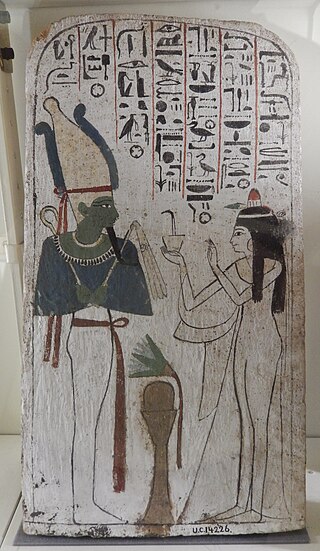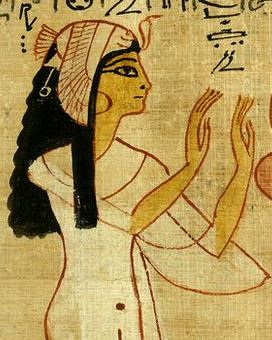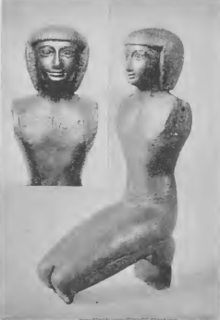
Titkheperure or Tyetkheperre Psusennes II [Greek Ψουσέννης] or Hor-Pasebakhaenniut II [Egyptian ḥr-p3-sb3-ḫˁỉ-⟨n⟩-nỉwt], was the last king of the Twenty-first Dynasty of Egypt. His royal name means "Image of the transformations of Re" in Egyptian. Psusennes II is often considered the same person as the High-Priest of Amun known as Psusennes III. The Egyptologist Karl Jansen-Winkeln notes that an important graffito from the Temple of Abydos contains the complete titles of a king Tyetkheperre Setepenre Pasebakhaenniut Meryamun "who is simultaneously called the HPA and supreme military commander." This suggests that Psusennes was both king at Tanis and the High Priest in Thebes at the same time, meaning he did not resign his office as High Priest of Amun during his reign. The few contemporary attestations from his reign include the aforementioned graffito in Seti I's Abydos temple, an ostracon from Umm el-Qa'ab, an affiliation at Karnak and his presumed burial – which consists of a gilded coffin with a royal uraeus and a Mummy, found in an antechamber of Psusennes I's tomb at Tanis. He was a High Priest of Amun at Thebes and the son of Pinedjem II and Istemkheb. His daughter Maatkare B was the Great Royal Wife of Osorkon I.

Pinedjem I was the High Priest of Amun at Thebes in Ancient Egypt from 1070 to 1032 BC and the de facto ruler of the south of the country from 1054 BC. He was the son of the High Priest Piankh. However, many Egyptologists today believe that the succession in the Amun priesthood actually ran from Piankh to Herihor to Pinedjem I.

Menkheperre, son of Pinedjem I by wife Duathathor-Henuttawy, was the High Priest of Amun at Thebes in ancient Egypt from 1045 BC to 992 BC and de facto ruler of the south of the country.

Psusennes I was the third pharaoh of the 21st Dynasty who ruled from Tanis between 1047 and 1001 BC. Psusennes is the Greek version of his original name Pasibkhanu or Pasebakhaenniut, which means "The Star Appearing in the City" while his throne name, Akheperre Setepenamun, translates as "Great are the Manifestations of Ra, chosen of Amun." He was the son of Pinedjem I and Henuttawy, Ramesses XI's daughter by Tentamun. He married his sister Mutnedjmet.

Hedjkheperre Setepenre Smendes was the founder of the Twenty-first Dynasty of Egypt and succeeded to the throne after burying Ramesses XI in Lower Egypt – territory which he controlled. His Egyptian nomen or birth name was actually Nesbanebdjed meaning "He of the Ram, Lord of Mendes", but it was translated into Greek as Smendes by later classical writers such as Josephus and Sextus Africanus. According to the Story of Wenamun from c. 1000 BC, Smendes was a governor of Lower Egypt during the Era of the Renaissance under the reign of Ramesses XI, however, Egyptologists have questioned the historical accuracy of this story.

Masaharta or Masaherta was the High Priest of Amun at Thebes between 1054 and 1045 BC.

Pinedjem II was a High Priest of Amun at Thebes in Ancient Egypt from 990 BC to 969 BC and was the de facto ruler of the south of the country. He was married to his full sister Isetemkheb D (both children of Menkheperre, the High Priest of Amun at Thebes, by Isetemkheb III, hence both nephew, niece and grandchildren of Psusennes I and also to his niece Nesikhons, the daughter of his brother Smendes II. He succeeded Smendes II, who had a short rule.
Djedkhonsuefankh was a High Priest of Amun in Thebes believed to have been in office from 1046–1045 BC.

The High Priest of Amun or First Prophet of Amun was the highest-ranking priest in the priesthood of the ancient Egyptian god Amun. The first high priests of Amun appear in the New Kingdom of Egypt, at the beginning of the Eighteenth Dynasty.

Neskhons, once more commonly known as “Nsikhonsou”, was a noble lady of the 21st Dynasty of Egypt.

Duathathor-Henuttawy, Henuttawy or Henttawy("Adorer of Hathor; Mistress of the Two Lands") was an ancient Egyptian princess and later queen.
Tentamun(“she of Amun”) was an ancient Egyptian queen, most likely the wife of Ramesses XI, last ruler of the 20th Dynasty. She is mentioned on the funerary papyrus of her daughter Duathathor-Henuttawy, who was the wife of Pinedjem I and probably the daughter of Ramesses XI. Tentamun's name is written in a cartouche.

Henuttawy D was an ancient Egyptian high priestess, a God's Wife of Amun, during the 21st Dynasty.
Mutnedjmet was an ancient Egyptian queen of the 21st Dynasty. She was the Great Royal Wife of her brother, Psusennes I.
Nesitanebetashru(ns-t3-nb.t-ỉšrw) was the name of two ancient Egyptian women. The name means “belonging to the lady of the ashru”; the ashru or isheru was a crescent-shaped sacred lake around the temples of solar goddesses, here it refers to Mut.
Gautseshen was an ancient Egyptian priestess, the singer of Montu. She lived during the Twenty-first Dynasty of Egypt.
Tjanefer was an ancient Egyptian priest during the reign of the Twenty-first Dynasty of Egypt.

Isetemkheb D was the sister-wife of the Theban High Priest of Amun Pinedjem II during the Twenty-first Dynasty of Egypt.

Nodjmet, Nedjmet, or Notmit was an ancient Egyptian noblewoman of the late 20th-early 21st dynasties of Egypt, mainly known for being the wife of High Priest of Amun at Thebes, Herihor.

Henuttawy or Henettawy, was an ancient Egyptian princess and priestess during the 21st Dynasty.














